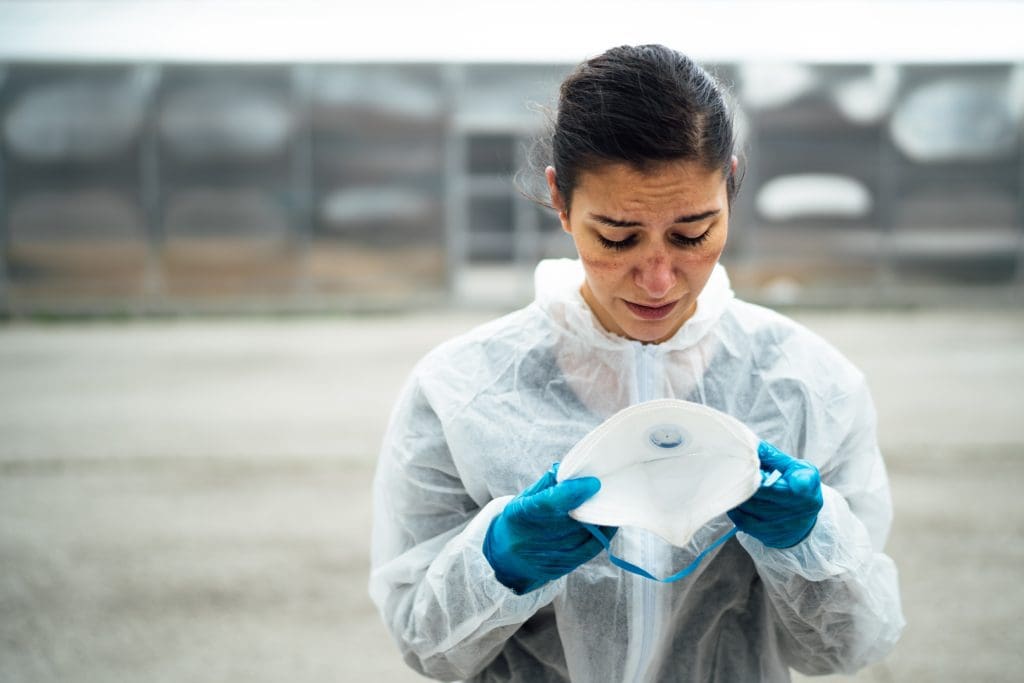From inadequate personal protective equipment (PPE) to caring for sicker patients, the COVID-19 pandemic has challenged the United States healthcare system in an unprecedented way. Under normal circumstances, nursing and physician burnout affects up to 54% of the workforce. Nursing burnout can lead to lower quality patient care, more clinical errors, and reduced patient satisfaction.
One source of burnout is an imbalance between the demands of the job and the resources available; lack of resources has been a particular problem in this pandemic. This and factors such as inadequate training and disaster response, have created significant psychological effects such as anxiety, depression—and burnout.
Imagine your mother being admitted to the hospital, alone, in the middle of this pandemic. Her first nurse, Jackie, is pleasant, attentive, and makes sure you mother doesn’t feel alone despite a hospital-wide visitor restriction. The next day, your mother’s nurse is Monica. Your mother rings the call bell to complain that she is having pain, and Monica’s response is, “You’ve maxed out your pain meds. You’ll just have to wait.” Meanwhile, Monica has gone 10 hours without using the bathroom, barely had time to eat a bite of crackers, and is holding the hand of her other patient who is dying alone. Monica is exhausted, but unable to call off from her shift because she is a dedicated employee, and her unit and her patients need her.
This is the grim realization of nursing burnout: Compassion and empathy are replaced with a “making do” attitude. Nurses experiencing burnout can feel helpless and distressed knowing that the care they are able to provide with the resources available to them do not align with the care they should be providing. Nursing burnout leads to your mother’s care being compromised because Monica didn’t assess her pain, which turned out to be related to an infection Your mother’s illness progressed to requiring care in the ICU. Your family is now burdened with the cost of ICU care, in addition to the distress of having your mother in the hospital for a longer period of time, and alone.
This pandemic has been particularly distressing for frontline workers, as we watch our colleagues lose their lives caring for COVID-19 patients. The first time I was assigned to care for a patient in our COVID-19 cohort, I found myself exhibiting signs of anxiety for most of my shift: hands shaking, breathing shallow, forgetfulness. My patient had a continuous I.V. infusion, which usually warrants an hourly check for infiltration. I felt guilty and selfish for not wanting to enter the room every hour and increase the likelihood I may be infected because I wanted to protect myself and my own family.
When my patient’s ventilator tubing accidentally became detached during repositioning, I felt panic wash over me as I reconnected the it: I had inadvertently caused an aerosol-generating procedure. I attempted to calm myself by noting that I was wearing an N95 mask and appropriate PPE, but I struggled to recall whether or not I did a seal check on my mask before entering the room. This is just a glimpse into the range of emotions felt throughout the shift of a nurse working with COVID-19 patients.
So, what actions should be taken to ease the burden of nurses and frontline workers? Your mother deserves better care than what Monica has given, and Monica deserves more resources from her workplace to help her manage the burnout she’s experiencing. First and foremost, Monica should recognize that she is exhibiting signs of burnout. Clinicians need to be provided education by their healthcare organization about the signs of burnout, as well as ways to combat burnout.
Burnout can be mitigated by encouraging coping techniques for the individual, such as yoga, writing, exercise, and employee assistance programs. In addition to Monica coping with her workplace stress and burnout, her hospital needs to find ways to build her resiliency. Building resiliency early on in a nurse’s career has been shown to decrease the likelihood of burnout across the span of one’s career. This can be done by providing adequate team and organizational support, using debriefing, making staff feel empowered and valued, and assigning mentors to staff.
Beyond the level of the individual, burnout prevention and mitigation should be addressed on a systemic level by the healthcare organization. Well-being programs, run by a chief wellness officer or other C-suite executive, should be designed and implemented after establishing a baseline level of organization-wide burnout and employee engagement. More immediately and affordably speaking, healthcare organizations can evaluate their nursing workload and work environments to decrease workload burden and create positive, effective work environments. Team-building activities to foster better communication and relationships among employees can be a cost-efficient way to start improving morale and work engagement.
As the world recovers financially from the crisis of COVID-19, we must also allow for emotional and mental recovery. This pandemic has caused an unprecedented amount of stress and burnout on healthcare workers. Let this be a call to action for healthcare organizations to provide their employees the resources to heal from psychological distress, especially the distress that this pandemic has caused. Reach out to your employees, listen to their needs, and support them through this harrowing time in their careers. Nurses, like Monica, and patients, like your mother, deserve better than the care than what is provided when staff burn out.
Rachel Baskin is adjunct clinical faculty and a PhD student at M. Louise Fitzpatrick College of Nursing, Villanova University, in Villanova, Pennsylvania.
References
Gaines K. Joint commission tackles nurse burnout in new report. 2019. https://nurse.org/articles/joint-commission-tackles-nurse-burnout/
National Academies of Sciences, Engineering, and Medicine. Taking action against
clinician burnout: A systems approach to professional well-being. Washington, DC: The National Academies Press.
Rushton C, Batcheller J, Schroeder K, Donohue P. Burnout and resilience amongnurses practicing in high-intensity settings. Am J Crit Care. 2019;24(5):412-21.
Shanafelt T, Trockel M, Ripp J, Murphy M, Sandborg C, Bohman, B. Building a program on well-being: Key design considerations to meet the unique needs of each organization. Acad Med. 2019;94(2):156-61.



















1 Comment.
It is stressful and crucial for all the health professionals now during this time of pandemic. There are a lot of nurses and doctors are also infected of this deadly virus. Simply staying at home as much as we can, proper hygiene, and eating healthy foods are ways we can help them.